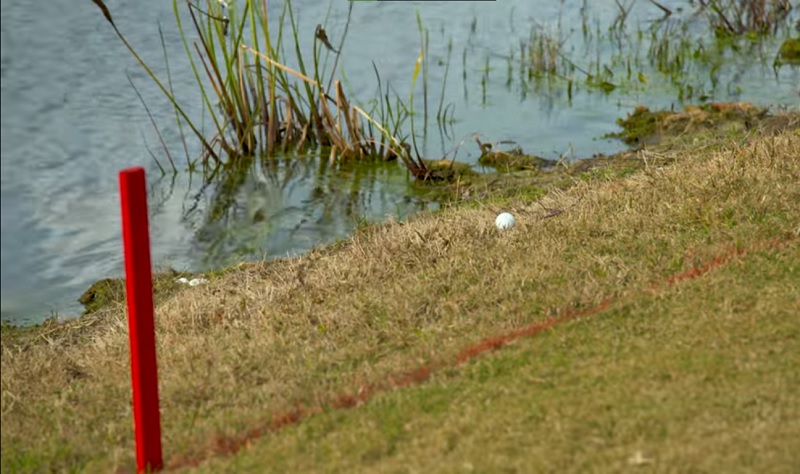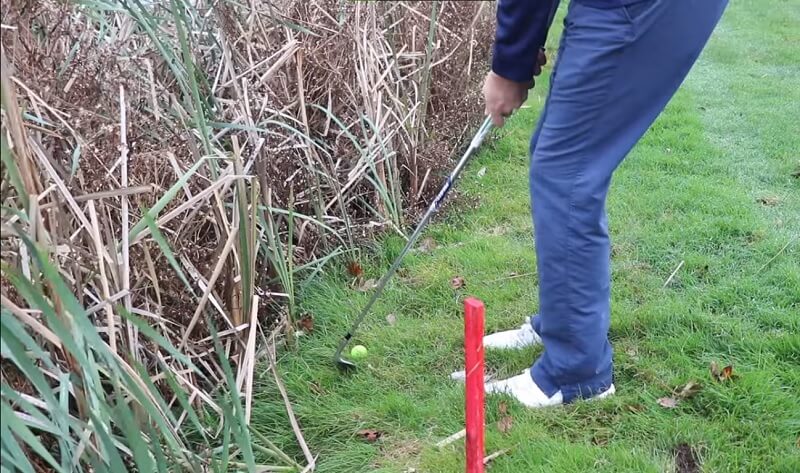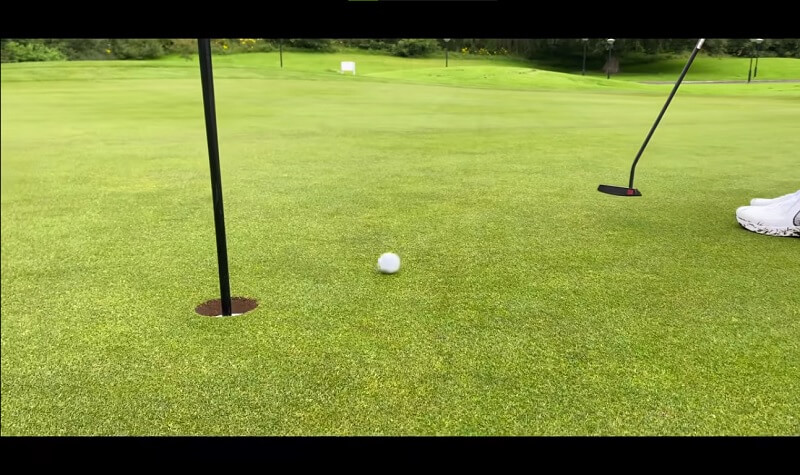What happens if I hit the ball in the area where I can’t find it?
What happens If the ball can not be found because it landed into a brush or areas that are hard to find?
What happens if I can’t find my ball within a long time and makes everyone wait for me?
…
In the beginning days of practicing golf, many of you are curious about these questions. And when it comes to this situation, you may hear about Provisional Ball. Though you realize that you can hit a provisional ball due to losing your original ball, you may not surely know what a Provisional Ball is and the rules about it.
In this article, we will cover what is a provisional ball in golf and explain it in the simplest way possible. We also provide you with other notions when you play a provision ball to avoid at least penalties and how to understand this rule properly.
What Is The Provisional Ball Rule In Golf?

The Provisional Ball is mentioned in Rule 18: “Stroke-and-Distance Relief; Ball Lost or Out of Bounds; Provisional Ball” of USGA.
For questions we talked about in the introduction, to make it clear and fair during a golf competition or even in a common golf play, especially in this case for saving time to look for the golf ball, the USGA passed Rule 18.
This rule includes Stroke and Distance Relief, Ball Lost or Out of Bounds, and Provisional Ball.
Rule 18.1 pertains to Stroke and Distance Relief. If you opt for stroke and distance relief at any time, the original ball ceases to be in play and must not be used, even if it is discovered on the course within the three-minute search time.
Rule 18.2 is about Ball Lost or Out of Bounds, which means when you can not find the previous hit ball, whether in a water hazard, bunker, or even the boundary.
Rule 18.3 is what we talk about today, the Provisional Ball, which means when you think your ball is lost or out of bounds, you can hit another without having to go back and hit a second shot from where the original was last played.
So, simply put, a provisional ball in golf is an extra ball that you can hit when you think your original one is lost or out of bounds; then, it will count as your next stroke and replace the original ball if it cannot be found.
To give you more about this rule, we break it down and explain it clearly in the next part. So, scroll your cursor to discover more!
When Is A Provisional Ball Allowed?

A provisional ball is allowed in golf when there is reasonable doubt that the original ball may be lost outside the penalty areas or out of bounds.
The purpose of playing a provisional ball is to save time by allowing you to continue playing without having to go back and re-hit the shot if the original ball cannot be found.
Here are a few scenarios when playing a provisional ball is allowed:
Lost Ball: If your ball is hit into an area with tall grass, bushes, dense rough, or any other location where finding it would be difficult, you can play a provisional ball. This ensures that you have a backup ball to continue playing with if the original ball is lost and cannot be found.
Out of Bounds: When your ball crosses the boundary of the course and goes out of bounds, you may play a provisional ball. This helps maintain a steady pace of play while you search for the original ball. If the original ball is found in bounds, you’ll continue to play with it. If not, you’ll continue with the provisional ball.
It’s important to note that a provisional ball is not allowed in certain situations.
The USGA stated in Rule 18.3: “But if you are aware that the only possible place your original ball could be lost is in a penalty area, a provisional ball is not allowed, and a ball played from where the previous stroke was made your ball in play under penalty of stroke and distance.”
This means excepting for the penalty areas such as red flags, bunker, and water hazards…you can play a provisional ball anywhere if you suppose that your original can be found or out of bounds.
When Is A Provisional Ball Becoming A Ball In Play?
The rules of golf state that a provisional ball becomes the ball in play under two conditions:
- When your original ball is lost anywhere on the course except in a penalty area or is out of bounds. If, after three minutes of searching, you have been unable to locate it, you must then proceed with playing the provisional ball as the one which counts.
- When your provisional ball is played from a spot nearer to the hole than where your original ball is estimated to be, this automatically makes the provisional ball become your new and only ball in play. You can no longer play from where you originally thought the original ball might be located and will need to count any strokes taken with the provisional ball from this point onwards.
When Is A Provisional Ball Abandoned?
There are 2 cases that the provisional ball must be abandoned:
The first is when the original ball is found on the course and out of the penalty areas within 3 minutes of searching. This ball will then become your ball in play from where you hit it originally.
The second is when the original ball is found in a penalty area or is certainly identified in the penalty area, the provisional cannot be used and must be abandoned. In this case, you’ll have to re-hit a shot from where the original was last played with a one-stroke penalty under Rule 18.1 Stroke and Distance Relief or play or original ball as it lies.
What Is The 3 Minutes Rule In Golf?
We mentioned 3 minutes to find the golf ball in the previous part. For some of you who don’t know about this rule, we added this small part to make everything clear for you.
The 3 minutes rule in golf refers to the time limit players have to search for a lost ball before it is considered lost and a stroke-and-distance penalty is incurred. This rule is part of Rule 18 in the Rules of Golf, specifically Rule 18.2.
If the ball is not found within the 3-minute time frame, it is deemed lost, and the player must proceed with stroke-and-distance relief.
Before, the USGA set a limit of 5 minutes for searching for the ball. After that, they reduce this time to 3 minutes to
The intention behind reducing the search time was to improve the pace of play and prevent unnecessary delays during a round.
By limiting the time spent searching for a lost ball, players are encouraged to make a reasonable effort to find the ball while also maintaining a reasonable pace of play.
Notions When You Play a Provisional Ball

First, you must announce or declare clearly that you will hit a provisional ball.
If you don’t declare it before hitting the provisional ball, which means you make two strokes at the same place where your original one was hit, then you will get a penalty of two strokes.
And especially note that you should declare correctly by saying the word is “provisional” or mentioning the “rule 18.3.” If you don’t do it, your provisional ball becomes in play under penalty of stroke and distance.
So, be sure to verbalize or announce that you are playing a provisional ball before hitting it.
Trying to hit in the same landing area or at least near it as much as possible. This helps if you find your original ball later on because it will be easier to determine if the provisional was played nearer to the hole than where the original ball lies.
Also, make sure you mark the spot of your original ball.
When you hit a provisional ball, make sure you mark down the spot that your original ball was last played from.
This way, if your original ball is found and you decide to continue with it, you can return to the exact spot from where it was last hit.
If you lose sight of your original ball, mark the spot with a tee or other object, as long as it doesn’t interfere with anyone’s stance or swing. Once this is done, you don’t need to worry about returning to your original spot and can continue playing with the provisional ball if the original is not found.
FAQs
How Many Strokes Is A Provisional?
A provisional ball should be recorded in the scorecard with a single-stroke penalty. You can also count any strokes taken to play the provisional ball as part of your total strokes but must still add one additional stroke penalty.
Is A Lost Ball A 2 Stroke Penalty?
The penalty for playing a provisional ball is one stroke under Rule 18.3 of the Rules of Golf. Depending on the circumstances, a lost ball can incur either a one-stroke or two-stroke penalty. If you are aware that your original ball could be in a penalty area, then you must take a two-stroke penalty to play from where your previous shot was made. However, if your ball is simply lost in play, then you can take a one-stroke penalty and will need to play a provisional ball.
How Many Times Can You Hit A Provisional Ball In Golf?
The rules of golf do not place a limit on the number of times a provisional ball can be played, but it is important to note that you must always declare it as such before hitting it. If your original ball is found, then any strokes taken with the provisional will need to be counted in your scorecard, and an additional penalty stroke will be added.
Conclusion
We hope this article has helped you to understand what a provisional ball is in golf and the rules that apply when it is used. Playing a provisional can be a great advantage if you are unsure where your original ball has gone, but make sure that you declare it as such before playing it to avoid incurring any additional penalties. Remember too to mark the spot of your original ball should you lose sight of it to avoid further trouble.


